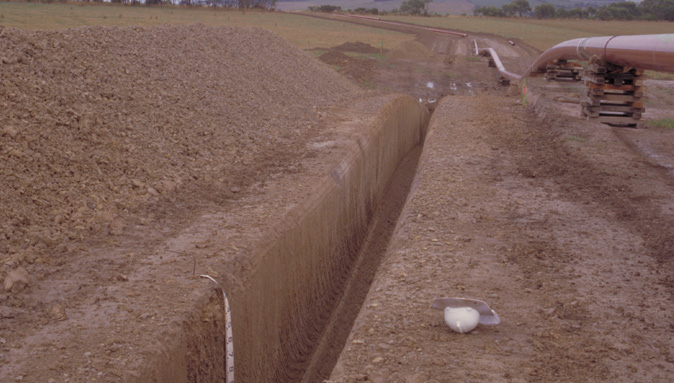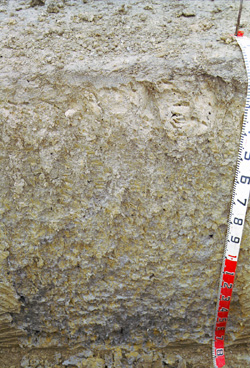SW54
Location: Cooriemungle.
Australian Soil Classification: Acidic, Eutrophic, Grey DERMOSOL.
General Landscape Description: Gleyed soil on an alluvial fan at the toe slope of a landslide.
Geology: Quaternary alluvium derived from Gellibrand Marl.
Land Use: Dairy cattle grazing.
 SW54 Landscape. |
Soil Profile Morphology:
Surface Soil
| A1 | 0-15 cm | Very dark greyish brown (10YR3/2); fine sandy loam; weak medium polyhedral structure; pH 5.7: abrupt and smooth change to: |  SW54 profile. Note: Surface (A) horizon has been stripped from the soil profile. |
| A2 | 15-35 cm | Grey (2.5Y6/1) conspicuously bleached (2.5Y7/2 dry); clay loam; apedal; strong consistence dry; pH 5.4; abrupt and smooth change to: | |
| Subsoil | |||
| B21g | 35-80 cm | Grey (2.5Y5/1) with yellowish brown (10YR5/6) mottles common; light clay; fine polyhedral structure; very firm consistence dry; pH 5.2; diffuse and smooth change to: | |
| B22g | 80-130 cm | Grey (2.5Y5/1) with many yellowish brown (10YR5/6) mottles; medium clay; coarse polyhedral or angular blocky, parting to coarse polyhedral structure; pH 5.2; diffuse and smooth change to: | |
| B23gss | 130 cm+ | Dark grey (2.5Y4/1) with a few yellowish brown (10YR5/6) mottles; medium heavy clay; coarse polyhedral or angular blocky, parting to coarse polyhedral structure; slickensides (up to 100 mm); pH 5.4. |
Key Profile Features:
- Gradual increase in clay content down the soil profile.
Soil Profile Characteristics:
pH | Salinity Rating | |||
Surface (A1 horizon) | Moderately Acid | Medium | Non-Sodic | None |
Subsoil (B21 horizon) | Strongly Acid | Low-Medium | Sodic | None |
Deeper Subsoil (at 80+ cm) | Strongly Acid | Low | Sodic | None |

| The surface is moderately acid. The subsoil is strongly acid. | Salinity rating is medium in the surface. The upper subsoil is low to medium becoming low at depth. | The surface is non-sodic the subsoil is sodic. | Clay content increases markedly at the surface / subsoil boundary. | Exchangeable Aluminium increases to very high levels in the subsoil. |
Horizon | Horizon Depth (cm) | pH (water) | pH (CaCl2) | EC (dS/m) | NaCl % | Exchangeable Cations | |||
Ca | Mg | K | Na | ||||||
meq/100g | |||||||||
A1 | 0-15 | 5.7 | 5.1 | 0.44 | 0.09 | 8.3 | 3.7 | 0.6 | 0.8 |
A2 | 15-35 | 5.4 | 4.5 | 0.19 | 2.7 | 3.2 | 0.44 | 1.2 | |
B21 | 35-80 | 5.2 | 4.4 | 0.25 | 3.2 | 4.9 | 0.41 | 1.6 | |
B22 | 80-130 | 5.2 | 4.4 | 0.26 | 0.06 | 3.7 | 6.5 | 0.2 | 1.5 |
B23 | 130+ | 5.4 | 4.5 | 0.23 | |||||
Horizon | Horizon Depth (cm) | Oxidisable Organic Carbon % | Total Nitrogen % | Exchangeable Aluminium mg/kg | Exchangeable Acidity meq/100g | Field Capacity pF2.5 | Wilting Point pF4.2 | Coarse Sand (0.2-2.0 mm) | Fine Sand (0.02-0.2 mm) | Silt (0.002-0.02 mm) | Clay (<0.002 mm) |
A1 | 0-15 | 4.3 | 0.37 | <10 | 14 | 42 | 16 | 7 | 31 | 27 | 22 |
A2 | 15-35 | 170 | 10 | 29 | 12 | 2 | 44 | 25 | 26 | ||
B21 | 35-80 | 270 | 11 | 32 | 32 | 2 | 40 | 21 | 36 | ||
B22 | 80-130 | 180 | 9.2 | 15 | 17 | 1 | 35 | 19 | 42 | ||
B23 | 130+ |
Management Considerations:
Whole Profile
- The high exchangeable aluminium levels measured in the strongly acid soil profile (below surface horizon) are likely to restrict the growth of aluminium sensitive species.
- The subsoil is slightly sodic but does not disperse. The high levels of exchangeable aluminium are likely to prevent dispersion occurring.
Profile Described By: Mark Imhof and Richard MacEwan (March 1999).


